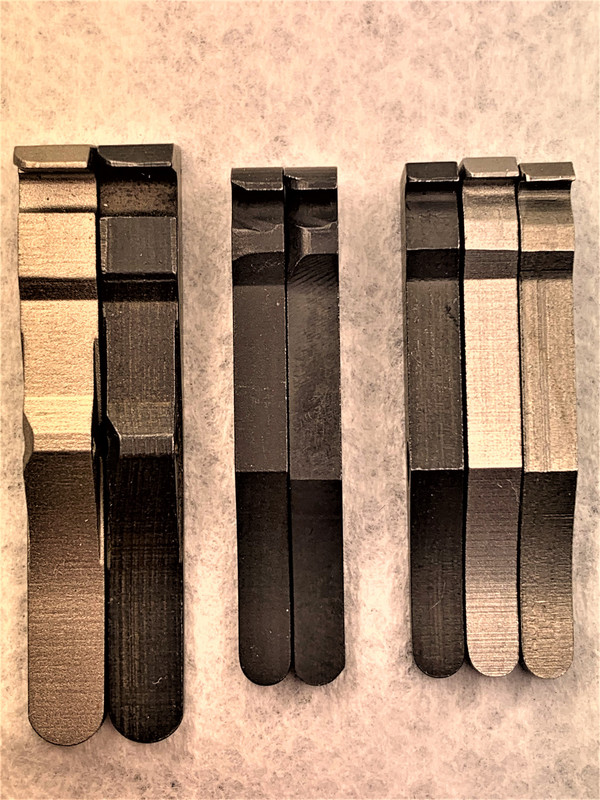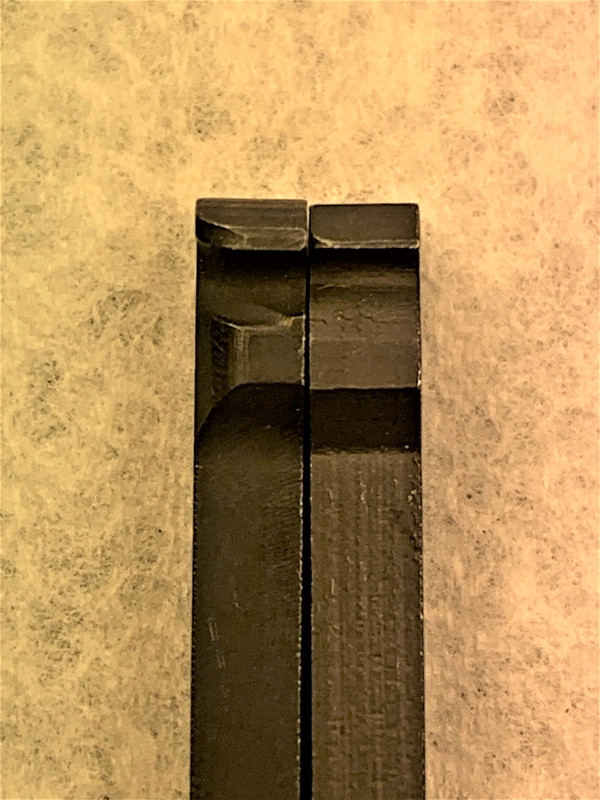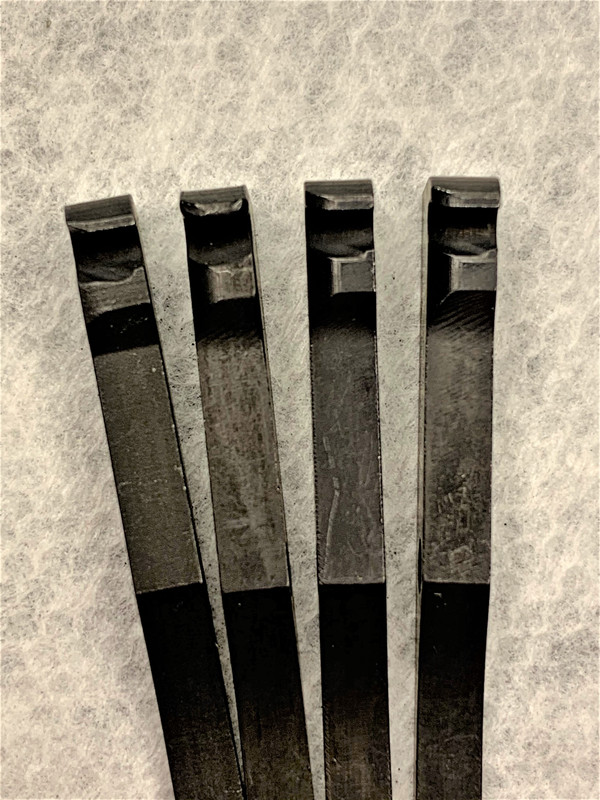An advantage of the external pivoting 1911 extractor (powered by a spring under its tail), versus the internal extractor (which is itself a spring)? The internal extractor has to be adjusted to the correct tension, and that tension can be changed and thrown off (reduced) by something as simple as letting the slide run forward over the rim of a chambered round. Maybe not once, or twice, etc, but bending it outward by having it cam
out and around a chambered round can "adjust" the tension the wrong way.
When S&W introduced the external extractor to their regular cataloged SW1911's (after the SW1911 line was shifted over to the regular factory from originally being a PC produced gun), they used the .40 extractor from their 3rd gen guns. It differed from their other 3rd gen extractors because of an added cut behind the hook.
Here's some new 3rd gen extractors. The wide pair on the left are for .45's; the pair in the middle are for .40's and the original SW1911; the 3 on the right are for 9's.

Here's a closer look at a 3rd gen .40/SW1911 .45 (left) and a 9 (right).

You can see the one of the left has a more rounded bevel on the bottom of the hook (left side, as in the pic), and it has an extra machined bevel cut behind the rear of the hook, which is lacking in the 9/.45 extractors. We were told that this extra rounding and bevel cut was to enhance feeding with the faster cycling .40 round.
Now, just to show how the engineers were continually revising things, here's a pic of 4 of the 3rd gen .40/SW1911. 45 extractors. If you look close, you can see that while all 4 of them have the small extra cut behind the hook (and behind where the case rim would be held), 1 of them lacks the rounded bottom edge behind the hook, as well as on the bottom of the edge of the actual hook. I'm guessing that this is an older 3rd gen .40 extractor I ordered many years ago, and the other 3 with the more rounded spots are newer revisions.

When I got the armorer manual for the standard SW1911's I called and ordered a factory SW1911 extractor Bar gauge. It was the same type of double-ended Go/No-Go gauge used to file/fit the extractor adjustment pads in the 3rd gen guns, but specifically made to check the dimensions of the extractor fit in the SW1911 slide, in case filing/fitting was needed.
The standard SW1911 extractor spring was the same Standard spring used in some of the later production 3rd gen guns, and there was also a Heavier than Standard spring available, if necessary. (just like were available for armorers to adjust extractor tension of 3rd gen guns.) The extractor spring tension is checked with the same Wagner Force Dial gauge that S&W 3rd gen pistol armorers used, and the recommended tension range was listed at 4-7lbs at the moment of deflection (.010" movement, basically meaning when you can see/feel it first begin to move when pulling on the extractor hook with the gauge tool).
I was also told that the new manufacturing tolerances of the slides were quickly making the need for the extractor Bar gauge probably only useful for confirming proper fit. I was told the newer extractors were usually dropping into the newer slides and being within the proper spec. (This soon followed with the M&P pistols, BTW, as in subsequent M&P armorer recert classes we were told we no longer needed to buy extractor Bar gauges for the .40/.357 guns, and they never even got around to making them for armorers for the 9/.45 M&P's, as they weren't necessary.)
Now, to my knowledge they discontinued the factory armorer classes for the SW1911 because the 1911 wasn't a mainstream LE/Gov weapon, and I don't think they ever got around to even offering one for the Enhanced models, either. The E-series got the taller .45 extractors formerly used in the other PC .45's (like the 945's), which necessitated a different (wider and lower) machining cut for the extractor recess on the slide, and I was told they had different extractor pins. I never got around to ordering a SW1911E model, so I didn't keep up on them.
Bottom line, for
me? I learned how to adjust the internal extractor for Colts in my Colt armorer class, and I own 4 Colts at the moment, so I can keep them adjusted as necessary. I only have the single SW1911 (a SW1911SC 5"), and if I ever need to replace the extractor, I have the parts and the tools (or, I could call S&W and have it repaired under warranty, with free shipping

).
I tend to think that
when done right, the external pivoting extractor is a robust and reliable design. Might even be less susceptible to owner/user induced problems that may cause the internal "spring" extractor to go out of adjustment.

Just my thoughts.




